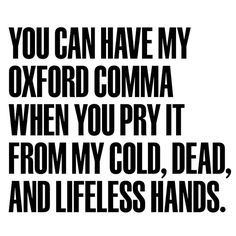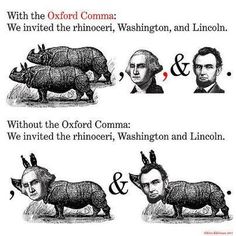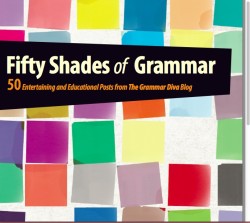 Ah . . .the Oxford comma — one of grammar’s most enduring battles. What is it,
Ah . . .the Oxford comma — one of grammar’s most enduring battles. What is it,  and why should you use it?
and why should you use it?
The Oxford comma is also known as the series comma. It is the comma that some people put before the conjunction (usually and) that introduces the final item in a series. It was first used by the Oxford University Press. However, its use goes in and out of style . . . some writers use it, while others abhor it and find that it clutters the text. Here is an example of both using and omitting the Oxford comma:
- The students included Tom, Luisa, Mike, Jimmy, Stacy, and Elizabeth. Oxford comma used.
- The students included Tom, Luisa, Mike, Jimmy, Stacy and Elizabeth. Oxford comma not used.
The above sentence is clear either way. Only an idiot would not be able to figure out that Stacy and Elizabeth are separate people.
But such is not always the case.
Recently, a Texas high school teacher made the news when he used this example (complete with drawings) to illustrate the importance of the Oxford comma to his class of sophomores:
- We invited the strippers, JFK and Stalin.
The teacher has apologized and has faced no undue punishment, since it was an isolated incident.
I think you can see the misunderstanding that can develop in some cases when the final series comma is not used. Are the strippers JFK and Stalin? Or are we talking about three separate people? This is much clearer:
- We invited the strippers, JFK, and Stalin. No room for misunderstanding here!
I actually used this example with my 7th graders, but I did change the wording! But not much! I think I said something along the lines of
- At the party were the supermodels, President Obama and Michelle Obama. Hmmm….
How about this sentence?
- I went out to lunch with my boss, the company CEO and a close friend.
Well, if I have used the Oxford comma in the rest of what I am writing, the reader would probably understand that it does not belong here, and I am talking about just one person, my boss, who is also the company CEO and a close friend of mine.
If I never use the Oxford comma, the reader might be confused. Am I talking about three people or just one? Did I really mean
- I went out to lunch with my boss, the company CEO, and a close friend.
In this case, I went out with three people. But if I never use the comma in my writing, a reader might be confused. If you don’t like the Oxford comma and you don’t use it, you do have to use it in this particular case if you do mean three people. Otherwise, your reader won’t know what you mean. That is why I think it is best to always use the Oxford to separate all items in the series. Then, when you don’t use it, that means the items are not separate.
Which brings us to the topic of consistency in your writing. Either use the Oxford or don’t in any one particular piece of writing. You can’t go back and forth. It might be confusing, and it will not look good. I personally like the Oxford (can you tell?), so when I am copyediting someone’s work, I consistently use it if they have been inconsistent. However, I don’t make them use it if it is clear they don’t want to. Obviously, I will put it in when it is necessary to avoid confusion.
Here are some examples where the Oxford comma would have really cleared things up!
- The reporter interviewed George Clooney’s two ex-girlfriends, Brad Pitt and John Hamm.
- I dedicated my new CD to my parents, John Lennon and God.
- Highlights of my recent trip included meeting the Prime Minister, a 102-year-old artist and a dildo collector.
- For dinner I ate chicken, potatoes and milk.
- Top news stories: world leaders meeting in Geneva, Obama-Castro handshake and same-sex marriage date set
- I was practicing my twerking with my cousins, Miley Cyrus and Louis CK.
- I traveled cross-country last summer with my boyfriend, a single father and a pole dancer.
Use the Oxford comma! It just makes sense!
Coming soon, fall/winter 2015!




great post
Thank you!